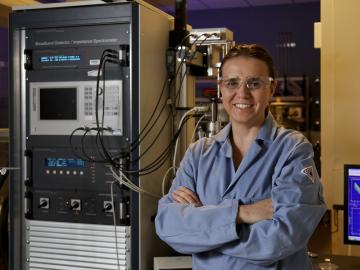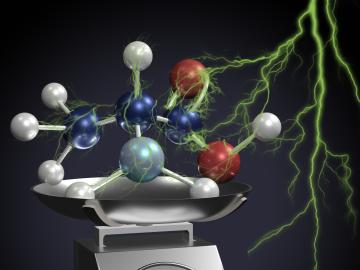
Filter News
Area of Research
- (-) Materials (70)
- Advanced Manufacturing (6)
- Biology and Environment (64)
- Building Technologies (2)
- Computational Biology (1)
- Computational Engineering (3)
- Computer Science (15)
- Electricity and Smart Grid (3)
- Energy Science (126)
- Energy Sciences (1)
- Functional Materials for Energy (1)
- Fusion and Fission (8)
- Fusion Energy (2)
- Isotopes (1)
- Materials for Computing (17)
- Mathematics (1)
- National Security (32)
- Neutron Science (18)
- Nuclear Science and Technology (7)
- Quantum information Science (8)
- Sensors and Controls (1)
- Supercomputing (145)
News Topics
- (-) Computer Science (17)
- (-) Frontier (3)
- (-) Grid (5)
- (-) Machine Learning (5)
- (-) Microscopy (27)
- (-) Molten Salt (3)
- (-) Polymers (17)
- (-) Quantum Computing (3)
- 3-D Printing/Advanced Manufacturing (23)
- Advanced Reactors (4)
- Artificial Intelligence (9)
- Big Data (2)
- Bioenergy (11)
- Biology (4)
- Biomedical (7)
- Buildings (5)
- Chemical Sciences (32)
- Clean Water (3)
- Composites (9)
- Coronavirus (4)
- Critical Materials (13)
- Cybersecurity (4)
- Energy Storage (34)
- Environment (15)
- Exascale Computing (2)
- Fusion (7)
- High-Performance Computing (4)
- Irradiation (1)
- Isotopes (13)
- ITER (1)
- Materials (73)
- Materials Science (78)
- Mathematics (1)
- Nanotechnology (39)
- National Security (3)
- Neutron Science (33)
- Nuclear Energy (16)
- Partnerships (11)
- Physics (28)
- Quantum Science (11)
- Security (2)
- Simulation (1)
- Space Exploration (2)
- Summit (2)
- Transportation (14)
Media Contacts

Quanex Building Products has signed a non-exclusive agreement to license a method to produce insulating material from ORNL. The low-cost material can be used as an additive to increase thermal insulation performance and improve energy efficiency when applied to a variety of building products.

A modern, healthy transportation system is vital to the nation’s economic security and the American standard of living. The U.S. Department of Energy’s Oak Ridge National Laboratory (ORNL) is engaged in a broad portfolio of scientific research for improved mobility

A new method developed at Oak Ridge National Laboratory improves the energy efficiency of a desalination process known as solar-thermal evaporation.

A team of researchers at Oak Ridge National Laboratory have demonstrated that designed synthetic polymers can serve as a high-performance binding material for next-generation lithium-ion batteries.

Scientists have discovered a way to alter heat transport in thermoelectric materials, a finding that may ultimately improve energy efficiency as the materials

Ionic conduction involves the movement of ions from one location to another inside a material. The ions travel through point defects, which are irregularities in the otherwise consistent arrangement of atoms known as the crystal lattice. This sometimes sluggish process can limit the performance and efficiency of fuel cells, batteries, and other energy storage technologies.

OAK RIDGE, Tenn., March 22, 2019 – Karren Leslie More, a researcher at the Department of Energy’s Oak Ridge National Laboratory, has been elected fellow of the Microscopy Society of America (MSA) professional organization.

Vera Bocharova at the Department of Energy’s Oak Ridge National Laboratory investigates the structure and dynamics of soft materials.

Oak Ridge National Laboratory scientists analyzed more than 50 years of data showing puzzlingly inconsistent trends about corrosion of structural alloys in molten salts and found one factor mattered most—salt purity.

OAK RIDGE, Tenn., Jan. 31, 2019—A new electron microscopy technique that detects the subtle changes in the weight of proteins at the nanoscale—while keeping the sample intact—could open a new pathway for deeper, more comprehensive studies of the basic building blocks of life.


